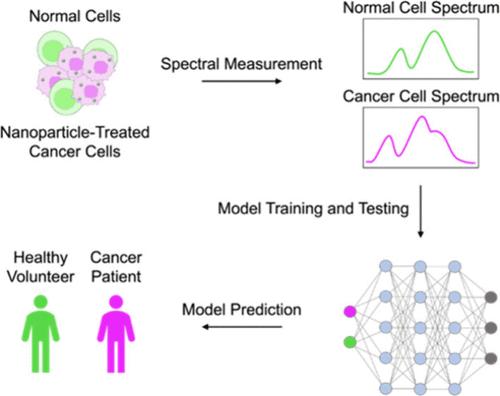通过机器学习提高基于纳米材料的癌症光学光谱检测能力
IF 11.3
1区 化学
Q1 CHEMISTRY, PHYSICAL
引用次数: 0
摘要
拉曼散射、荧光和红外吸收光谱等依靠光-物质相互作用的光学光谱技术在补充现有癌症检测方法方面具有众多优势。通过将这些光谱技术与合理设计的纳米材料相结合,可以更有针对性地靶向癌细胞和组织,并大大增强读出信号。进一步整合机器学习及其识别微妙恶性肿瘤指标的潜力,可显著提高纳米材料光学光谱学更精确地划分癌症的能力。因此,光学光谱学、纳米材料和机器学习的协同整合可为开发选择性更强、更灵敏、更准确的癌症诊断技术提供独特的机会,并可利用这些技术优化治疗策略,尽量减少不必要的干预,最终提高患者的生存率。本视角介绍了结合光学光谱学、纳米材料和机器学习来改进癌症检测的多种策略,并总结了我们对这一新兴领域的现状和未来潜在发展方向的展望。本文章由计算机程序翻译,如有差异,请以英文原文为准。

Enhancing Nanomaterial-Based Optical Spectroscopic Detection of Cancer through Machine Learning
Optical spectroscopic techniques relying on light–matter interactions, such as Raman scattering, fluorescence, and infrared absorbance spectroscopy, offer numerous advantages to complement existing cancer detection methods. By combining these spectroscopic techniques with rationally engineered nanomaterials, cancer cells and tissues can be more specifically targeted, and the readout signals can be substantially enhanced. Further integration of machine learning with its potential to identify subtle malignancy indicators may significantly improve the capability of nanomaterial-enabled optical spectroscopy to delineate cancer more precisely. As such, the synergistic integration of optical spectroscopy, nanomaterials, and machine learning may provide unique opportunities for the development of more selective, sensitive, and accurate cancer diagnostic technologies, which can be leveraged to optimize therapeutic strategies and minimize unnecessary interventions to ultimately enhance patient survival outcomes. This Perspective describes numerous strategies incorporating optical spectroscopy, nanomaterials, and machine learning to improve cancer detection and summarizes our outlook on the current landscape and potential future directions of this emerging field.
求助全文
通过发布文献求助,成功后即可免费获取论文全文。
去求助
来源期刊

ACS Catalysis
CHEMISTRY, PHYSICAL-
CiteScore
20.80
自引率
6.20%
发文量
1253
审稿时长
1.5 months
期刊介绍:
ACS Catalysis is an esteemed journal that publishes original research in the fields of heterogeneous catalysis, molecular catalysis, and biocatalysis. It offers broad coverage across diverse areas such as life sciences, organometallics and synthesis, photochemistry and electrochemistry, drug discovery and synthesis, materials science, environmental protection, polymer discovery and synthesis, and energy and fuels.
The scope of the journal is to showcase innovative work in various aspects of catalysis. This includes new reactions and novel synthetic approaches utilizing known catalysts, the discovery or modification of new catalysts, elucidation of catalytic mechanisms through cutting-edge investigations, practical enhancements of existing processes, as well as conceptual advances in the field. Contributions to ACS Catalysis can encompass both experimental and theoretical research focused on catalytic molecules, macromolecules, and materials that exhibit catalytic turnover.
 求助内容:
求助内容: 应助结果提醒方式:
应助结果提醒方式:


